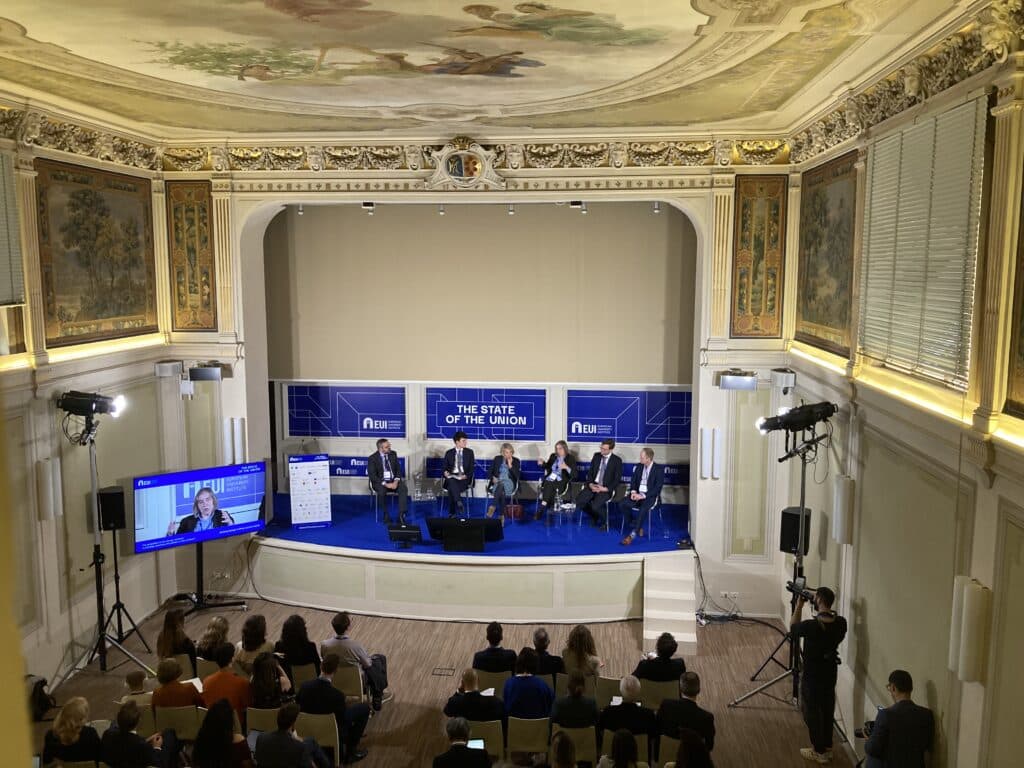Our last #FSRDebate addressed the crucial question of how policymakers and regulators can avoid carbon lock-in jeopardising the attainment of the European Union’s ambitious energy and climate targets. Leigh Hancher (Florence School of Regulation and Tilburg University) welcomed all participants and introduced the speakers giving the opening presentations, Nicola Pesaresi (DG Competition, European Commission) and Claire Thornhill (Frontier Economics).
Mr Pesaresi first mentioned that, while the Commission has been discussing the issue of carbon lock-in during the preparation of the new guidelines for State aid in the area of energy and environmental protection, it is a subject that has not seen a lot of important developments in terms of case practice. Such practice would be fundamental in order to develop standards on how to approach the risk of lock-in effects. The new guidelines for State aid for Climate, Energy and Environment (CEEAG) have been drafted keeping in mind the priorities of the European Green Deal. Therefore, they aim at ensuring coherence with the Union’s climate targets. They aim to contribute to the phasing out of subsidies for fossil fuels, as well as the promotion of subsidies for green technologies.
The question of how to avoid lock-in is more complex when it comes to natural gas natural as opposed to the most polluting fossil fuels such as coal or lignite. Mr Pesaresi stated that this is because gas is a fuel that may have a role in the energy transition, and this is reflected in the guidelines. Nevertheless, the State aid guidelines for projects involving natural gas require that these projects should be subject to important safeguards to ensure compatibility with the Union’s 2030 and 2050 climate targets. In particular, the guidelines say that it is important that support for natural gas projects does not lead to lock-in effects. The guidelines require the Member States to explain, in the context of any measure involving support for new investments in generation based on natural gas, how these proposed projects are compatible with the 2030 and 2050 targets and how lock-in will be avoided. The explanation that Member States need to provide may be based on a national decarbonisation plan with binding targets and may include binding commitments by the beneficiary to implement decarbonisation technologies. For example, CCS or CCUS projects, the replacement of natural gas with renewable or low-carbon gas, or the closure of the plant on a timeline which is consistent with the Union’s climate targets.
Ms Thornhill commented that carbon lock-in refers to situations where emissions-intensive assets continue to be used even when low-carbon and socially more beneficial assets are available. She agreed with Mr Pesaresi that the gas sector is an area where there is a lot of nuance and a lot of uncertainty over what type of assets might be prone to lock-in. Frontier Economics has defined a set of practical questions to assess the risk of lock-in. First, a set of ‘filter’ questions is asked that determines which projects should then be assessed on a more detailed level. These questions are:
- Is it a long-lived asset?
- Does it have high direct or indirect emissions?
If the answer to either of these questions is no, then lock-in risk is likely to be very low. If the answer is yes to both of these questions, then the Frontier methodology suggests that an assessment is undertaken in three key areas:
- Economic factors: once the investment cost of the asset has been sunk, will it be cheaper to continue running it instead of investing in a in a low-carbon substitute?
- Market factors: is the operator of the asset likely to have market power? Do the contractual structures potentially create barriers to entry?
- Political factors: is the asset in a sector characterised by influential lobby groups? Would it provide (directly or indirectly) a large level of employment?
If the answer is yes to any of these questions, lock-in might be a risk and a more detailed explanation of why this asset would not lead to lock-in or the introduction of mitigating measures would be appropriate. Ms Thornhill emphasised that assessments of lock-in risks should be timely, and pragmatic, and should avoid loopholes if they are to be effective. Further, these assessments should be part of initial project development, rather than being considered a mere ‘compliance hoop’ to jump through at the last minute.
Panel Discussion
After the conclusion of the opening presentations, Prof. Hancher introduced the expert panel, composed of Jakub Przyborowicz (GIE); Stéphanie Nieuwbourg (ClientEarth); Russell Bishop (EBRD); and Walter Boltz (Regulatory Expert). She then invited each of the panellists to briefly present their perspective on the topic.
Mr Przyborowicz said that the members of GIE are keenly aware of the need to avoid carbon lock-in. He stated that retrofit and repurpose initiatives are already happening. Mr Przyborowicz also said that GIE had already taken steps to investigate how LNG terminals could be used for bio-LNG or liquid hydrogen. While existing LNG infrastructure can be relatively easily converted to work with bio-LNG, its suitability for liquid hydrogen is likely to require more investment. Further, GIE already has Members who are planning for the conversion of gas storage facilities into hydrogen storage. He stated that gas storage in salt caverns is particularly suited to such conversion.
In her intervention, Ms Nieuwbourg stated that the Commission’s guidelines do not define lock-in, and that this notion will need to be further developed and will evolve over time in case practice. She stressed the need for firm binding commitments from aid beneficiaries and that State aid decisions should contain very stringent conditionality and binding timelines, as well as transparent and close evaluation by Member States and monitoring by the European Commission. Regarding the type of binding commitments that Member States can give to demonstrate that lock-in is being avoided, Ms Nieuwbourg cautioned against commitments involving CCS and CCU, arguing that these technologies could actually be a driver of lock-in by shifting the attention away from more sustainable solutions such as energy efficiency measures. In case such binding commitments to implement CCUS are being made, they it should be accompanied by a binding and detailed implementation plan. Ms Nieuwbourg welcomed the prospect of additional Commission guidance on the notion of carbon lock-in, because leaving that definition up to Member States would likely lead to difficulties.
Mr Bishop explained that the EBRD already assesses all potential investments regarding the project’s alignment with the Paris Agreement. The Bank has defined such alignment as having two criteria: consistency with a low-carbon pathway; and a low risk of carbon lock-in. Given that there is no one clear definition of carbon lock-in, the EBRD has developed its own of working definition of the concept. This centres around the notion of the existence of technical, economic, or institutional factors which lead to a high-carbon asset continuing to operate in an emissions-intensive way when there are technically and economically feasible alternatives that
could replace it. In practice, when assessing the risk of carbon lock-in presented by a project, the EBRD starts by ruling out projects where it is relatively easy to demonstrate a very high or very low risk of carbon lock-in, coal being an example of the former. Conversely, the EBRD uses the EU Taxonomy for Sustainable Activities to identify projects that are very unlikely to create carbon lock-in. When it cannot clearly be demonstrated that projects present a very high or very low lock-in risk, the EBRD enters into a more granular assessment of the project to determine the risk. Concluding, Mr Bishop emphasised that lock-in should not just be a concern when it comes to energy infrastructure, but also regarding investments in other sectors, such as transport. The nuances and specificities of the sector in question should always be taken into account. Secondly, it is important to take a country-specific approach to lock-in. Finally, Mr Bishop stated that we need to think about how efforts to avoid carbon are integrated into the decision-making process of institutions confronting this issue.
Mr Boltz focused on regulated assets, these being the area where regulators have a proactive role. The tools that regulators have at their disposal are primarily the ten-year network development plans, the national and regional investment plans, and, within those plans, the cost-benefit analysis or the cross-border cost allocation. There is no clear guidance for energy regulators how to approach lock-in in those plans. Mr Boltz argued that the tools and the approach to tackle this issue will probably evolve over time and we will see an increase of complexity and more and more sophistication in this area. However, he cautioned that, in 2022 and 2023, he expected security of supply to be the dominant issue, meaning that at least some investments would be likely to be pushed through, irrespective of whether they create a lock-in effect or not.
Participant Polls
After the presentations by the panellists, a series of polls was put to participants. The first of these polls asked participants what they considered to be the key driver of carbon lock-in: economic, market, or political factors. 55% of those attending responded that all of these factors were equally likely to create lock-in. A second poll revealed that 55% of participants thought that any increase in lock-in risk created by the construction of additional gas infrastructure as a response to the Ukraine crisis could be mitigated if there were scope for conversion of such infrastructure to transport low-carbon and renewable gases. In a third poll, 73% of participants stated that the methodologies for assessing the risk of carbon lock-in should be the same under EU State aid rules as under the Taxonomy Regulation.
Conclusion
After a lively Q&A session, Prof. Hancher concluded the event by thanking all speakers and panellists for an excellent discussion of a crucial and timely subject.






